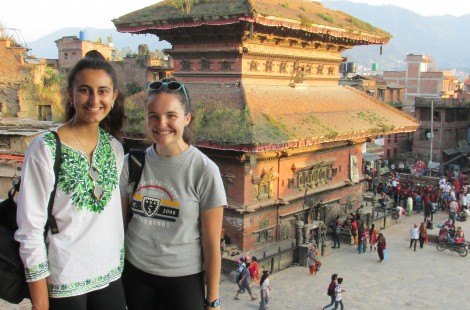
In 2018 I travelled to Nepal to teach with HELP (Helambu Education and Livelihood Partnership) in rural Nepal.
After arriving in Kathmandu, we had a day to explore Boudha and its magnificent Boudhanath stupa before heading into the hills. For four weeks, we stayed in Langarche, a village which is located at an altitude of 1800m in the Panch Pokhari Valley. To reach the village it took a 2 hour jeep ride and an arduous 8 hour uphill walk from the nearest town of Melamchi; the village could only be reached by foot as the nearby roads had been destroyed by the monsoon rains.
We arrived to a welcoming ceremony where flowers and scarves were presented to us by the students of Shree Naulingeshwory Basic School, the school we were to be teaching at. The school was completely destroyed by the 2015 earthquake. Four permanent, earthquake resistant classrooms are currently being built but until April 2019, when completion is estimated, the children are being taught in Temporary Learning Centres which consist of steel cladding roofs which were held up by logs. At school, we taught English to Nursery and Classes 1 to 5, children aged between 3 and 8. Prior to our arrival the primary method of teaching was the teacher would read out of the book and the students would repeat what they said so we introduced new methods to make learning more fun and interactive such as drawing, answering questions on the whiteboard and the greatly popular stickers! Things we taught included: grammar, colours, numbers and animals and we also helped the teachers to improve their English, focusing on pronunciation, as all subjects are taught in English therefore improving their level of English is of great importance. There were many challenges along the way, especially with communication at the start, but by the time it had come for us to leave, the level of the teachers' and students' English had greatly improved, as had our Nepali!
The people living in the village are of the Tamang indigenous group and most people practice subsistence farming. We observed numerous festivals while there including Janai Purnima and Teej, which allowed us to see insight into their rich cultural heritage. We lived with an amazing host family who did a fabulous job of catering for our every need. They had a farm where they grew their supplies and they owned the local shop which sold just about everything! From their very basic kitchen, consisting of a fire pit in the corner of the room, we were fed pumpkin leaf curry and the very traditional ‘Dal Bhat’ for every meal, which although was tasty, was very repetitive! We also encountered lots wildlife in the village; goats, yaks, snakes, leeches and monkeys; which although we loved, the villagers hated as they stole their corn!
When the time had come for us to leave Langarche, there was yet more dancing, scarves and flowers before our descent down the mountain. We returned to Kathmandu and spent a few days exploring where we visited: Swayambhunath, Bhaktapur Durbar Square, Kathmandu Durbar Square and Thamel, where we were able to see how the 2015 earthquake failed to topple some of the city’s most beautiful and intricately designed temples and learn about their cultural significance to the Nepali people.
This amazing opportunity allowed us to gain an insight into Nepali culture by integrating into a rural community for four weeks. This was an incredibly eye opening experience and although at times was challenging, this experience, especially being able to teach the amazing students, was very rewarding and fascinating and I am grateful to the Gateway scheme for giving me the opportunity to do this.
Helen Essell
Geography